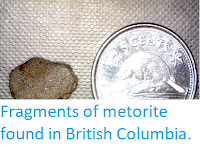Each year between 15 and 18 November (approximately), typically peaking
between midnight and dawn on 17 November, the the Earth
encounters the Leonid Meteors, one of the more spectacular of the annual
meteor showers, and viewing could be good this year as the shower peaks just before the New Moon on 18 November. Unlike most such
showers, which are essentially
composed of dust particles, the Leonids comprise particles of up to 8 mm
across and up to 85 g in mass, leading to some spectacular fireballs,
and each year the shower is thought to deposit 12-13 tonnes of material
on the Earth. The Leonid Meteor Shower is so called because the meteors
they appear to originate in the constellation of Leo. (Note a meteor is a
'shooting star', a piece of material visibly burning up in the
atmosphere and detectable via the light it produces when doing this; a
meteorite is a piece of rock that has fallen from the sky and which a
geologist can physically hold; and an asteroid is a chunk of rock in
orbit about the Sun, to small to be regarded as a planet.
The radiant point (apparent point of origin) of the Leonid Meteors. Space.com.
The Leonid Meteors are thought to originate from the tail of Comet
55P/Tempel-Tuttle, which orbits the Sun every 33 years, on an orbit that
brings it slightly within the orbit of the Earth then out to slightly
beyond the orbit of Uranus. Comets are composed largely of ice (mostly
water and carbon dioxide), and when they fall into the inner Solar
System the outer layers of this boil away, forming a visible tail (which
always points away from the Sun, not in the direction the comet is
coming from, as our Earth-bound experience would lead us to expect).
Particles of rock and dust from within the comet are freed by this
melting (strictly sublimation) of the comet into the tail and continue
to orbit in the same path as the comet, falling behind over time.
Image of Comet 55P/Tempel-Tuttle taken in February 1998 from the National Astronomical Observatory of Japan. Cometography.
The material in the meteor shower is densest close behind the comet, and, since Comet 55P/Tempel-Tuttle has a 33 year orbit, the
Leonid Meteor Shower has a 33-year cycle, with a particularly
spectacular display every thirty-third year, then a gradual decline in
meteor number till the end of the cycle. The last such peak year was in
1998.
Comet 55P/Tempel-Tuttle was discovered in December 1865 by German astronomer Wilhelm Tempel, and independently in January 1866 by the American Horace Parnell Tuttle. The designation 55/P implies that it is a Periodic Comet (comet with an orbital period of less than 200 years), and that it was the 55th such body discovered. As a Comet with a Period of less than 200 years and more than 20 years it is also regarded as a Halley-type Comet.
See also...
Follow Sciency Thoughts on Facebook.








